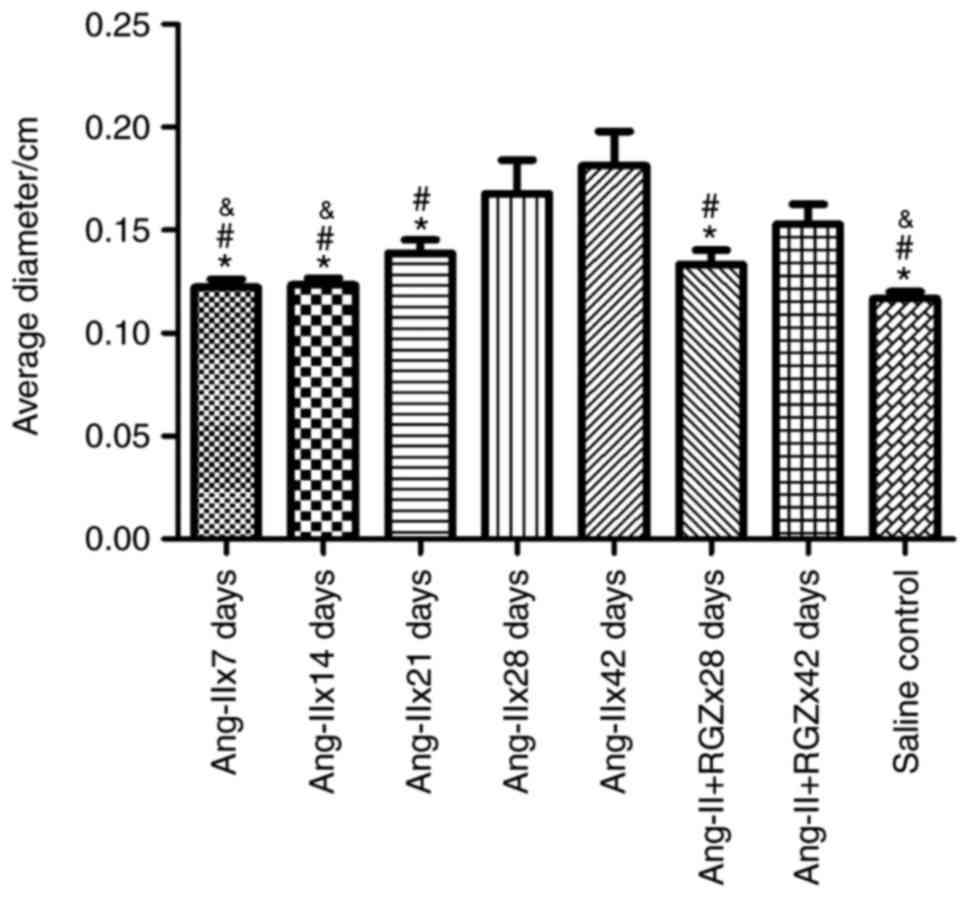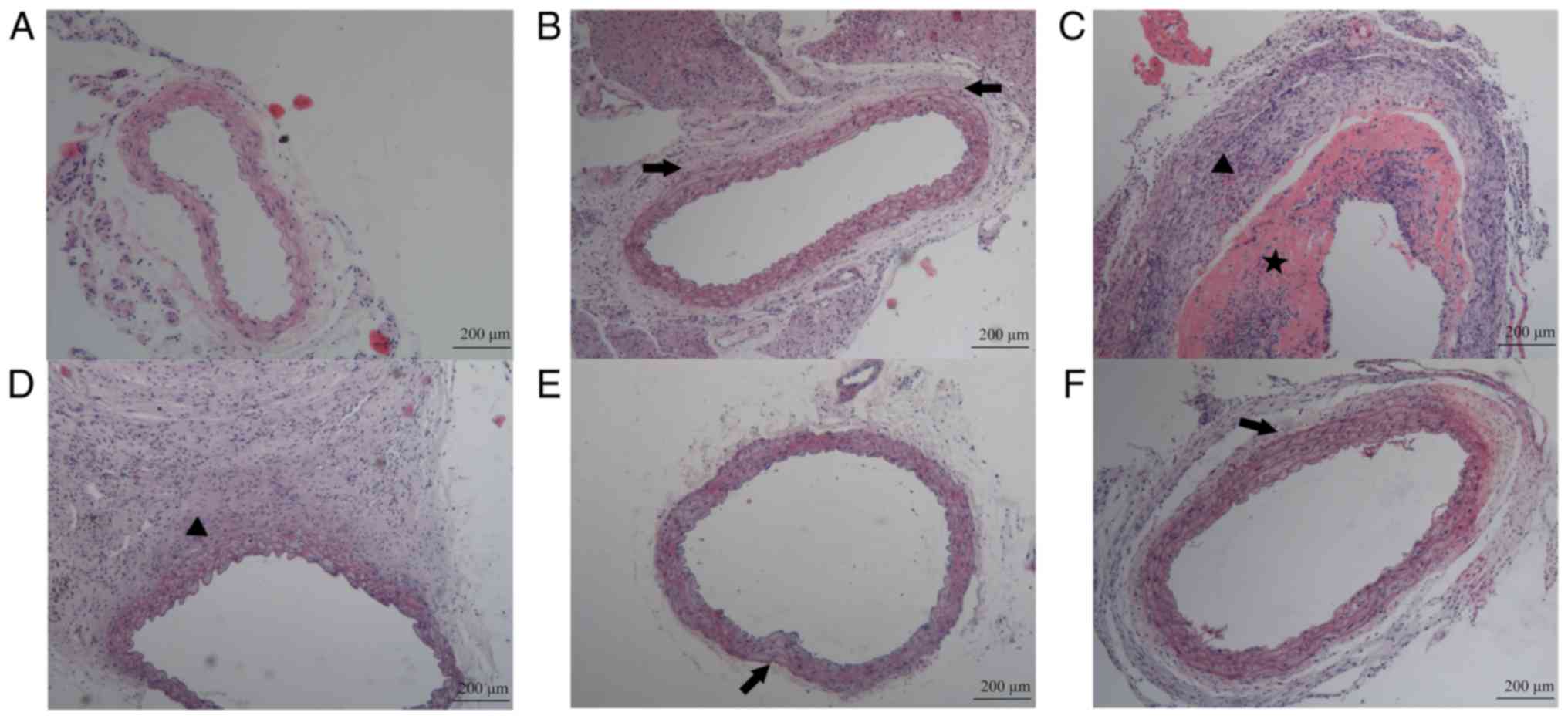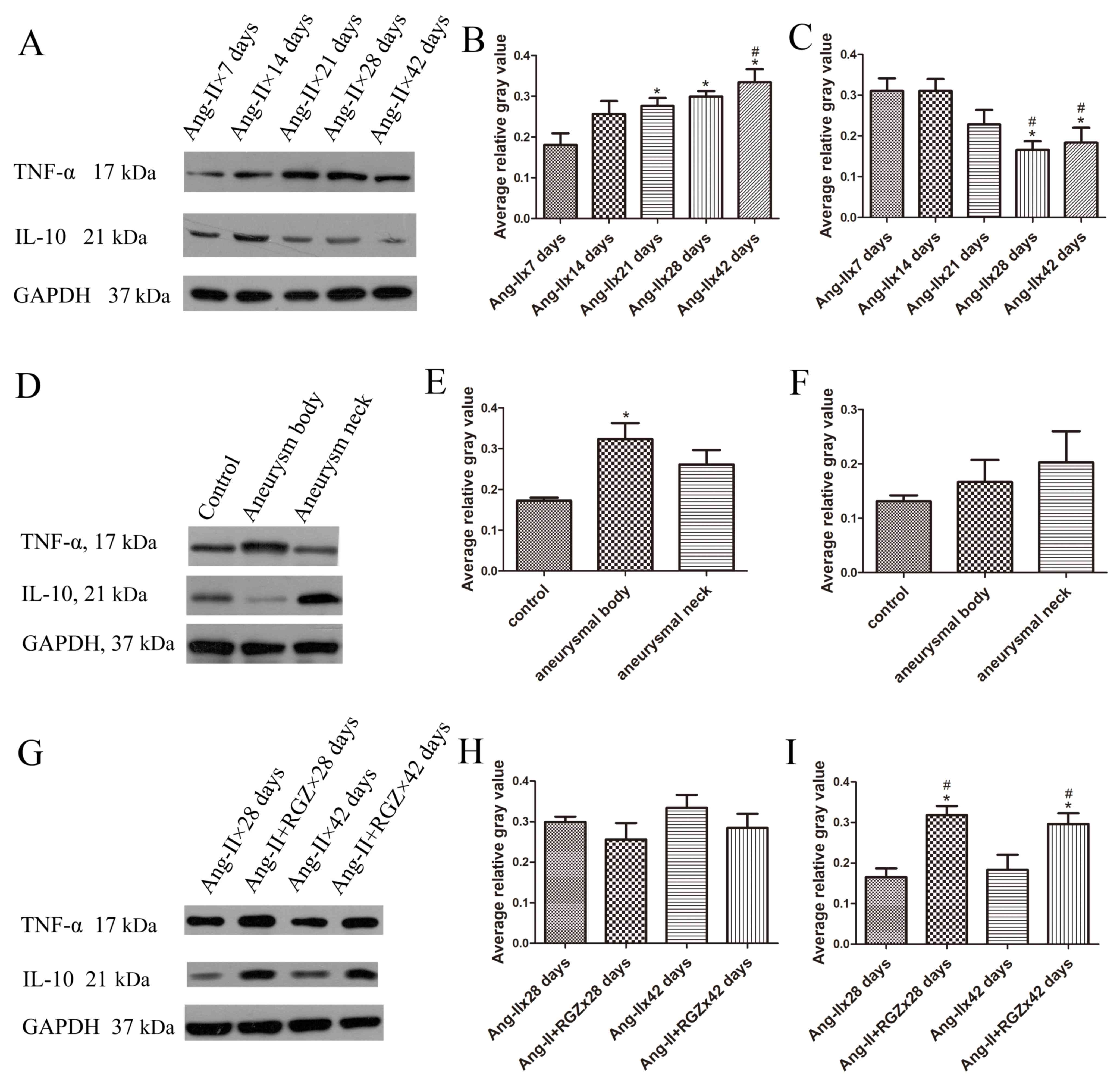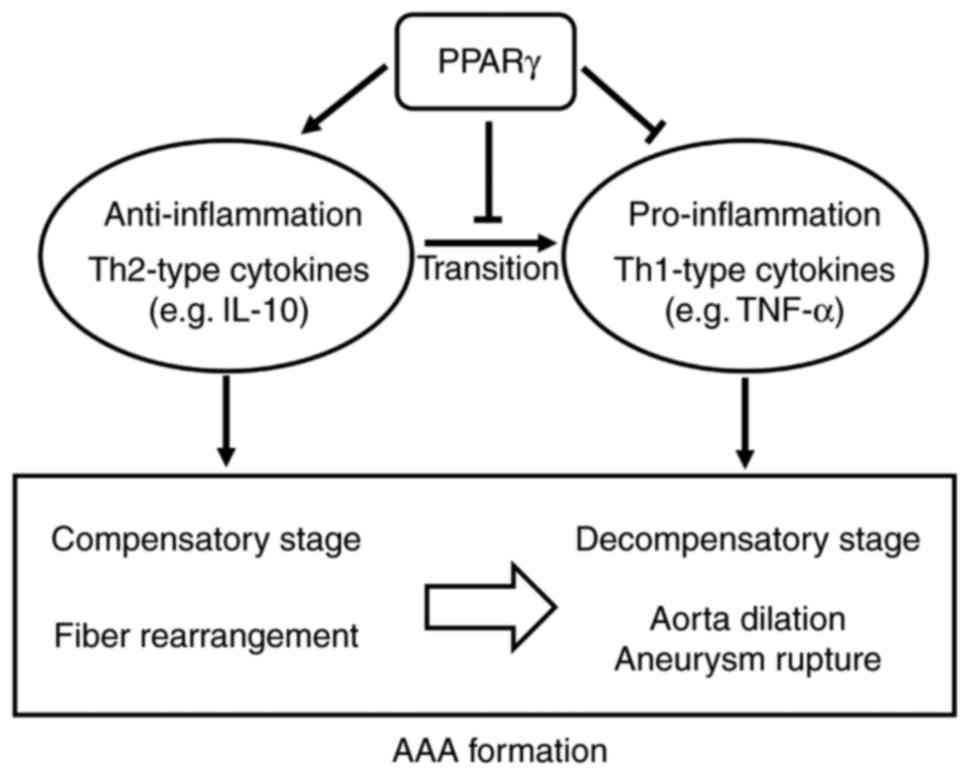|
1
|
Singh K, Bønaa KH, Jacobsen BK, Bjørk L
and Solberg S: Prevalence of and risk factors for abdominal aortic
aneurysms in a population-based study: The Tromsø study. Am J
Epidemiol. 154:236–244. 2001. View Article : Google Scholar : PubMed/NCBI
|
|
2
|
Eagleton MJ: Inflammation in abdominal
aortic aneurysms: Cellular infiltrate and cytokine profiles.
Vascular. 20:278–283. 2012. View Article : Google Scholar : PubMed/NCBI
|
|
3
|
Schönbeck U, Sukhova GK, Gerdes N and
Libby P: T(H)2 predominant immune responses prevail in human
abdominal aortic aneurysm. Am J Pathol. 161:499–506. 2002.
View Article : Google Scholar : PubMed/NCBI
|
|
4
|
Xiong W, Zhao Y, Prall A, Greiner TC and
Baxter BT: Key roles of CD4+ T cells and IFN-gamma in the
development of abdominal aortic aneurysms in a murine model. J
Immunol. 172:2607–2612. 2004. View Article : Google Scholar : PubMed/NCBI
|
|
5
|
Shimizu K, Libby P and Mitchell RN: Local
cytokine environments drive aneurysm formation in allografted
aortas. Trends Cardiovasc Med. 15:142–148. 2005. View Article : Google Scholar : PubMed/NCBI
|
|
6
|
Shimizu K, Mitchell RN and Libby P:
Inflammation and cellular immune responses in abdominal aortic
aneurysms. Arterioscler Thromb Vasc Biol. 26:987–994. 2006.
View Article : Google Scholar : PubMed/NCBI
|
|
7
|
Jones A, Deb R, Torsney E, Howe F, Dunkley
M, Gnaneswaran Y, Gaze D, Nasr H, Loftus IM, Thompson MM and
Cockerill GW: Rosiglitazone reduces the development and rupture of
experimental aortic aneurysms. Circulation. 119:3125–3132. 2009.
View Article : Google Scholar : PubMed/NCBI
|
|
8
|
Croasdell A, Duffney PF, Kim N, Lacy SH,
Sime PJ and Phipps RP: PPARγ and the innate immune system mediate
the resolution of inflammation. PPAR Res. 2015:5496912015.
View Article : Google Scholar : PubMed/NCBI
|
|
9
|
Motoki T, Kurobe H, Hirata Y, Nakayama T,
Kinoshita H, Rocco KA, Sogabe H, Hori T, Sata M and Kitagawa T:
PPAR-γ agonist attenuates inflammation in aortic aneurysm patients.
Gen Thorac Cardiovasc Surg. 63:565–571. 2015. View Article : Google Scholar : PubMed/NCBI
|
|
10
|
Celinski K, Dworzanski T, Korolczuk A,
Piasecki R, Slomka M, Madro A and Fornal R: Effects of peroxisome
proliferator-activated receptors-gamma ligands on dextran sodium
sulphate-induced colitis in rats. J Physiol Pharmacol. 62:347–356.
2011.PubMed/NCBI
|
|
11
|
Pisanu A, Lecca D, Mulas G, Wardas J,
Simbula G, Spiga S and Carta AR: Dynamic changes in pro- and
anti-inflammatory cytokines in microglia after PPAR-γ agonist
neuroprotective treatment in the MPTPp mouse model of progressive
Parkinson's disease. Neurobiol Dis. 71:280–291. 2014. View Article : Google Scholar : PubMed/NCBI
|
|
12
|
Golledge J, Cullen B, Rush C, Moran CS,
Secomb E, Wood F, Daugherty A, Campbell JH and Norman PE:
Peroxisome proliferator-activated receptor ligands reduce aortic
dilatation in a mouse model of aortic aneurysm. Atherosclerosis.
210:51–56. 2010. View Article : Google Scholar : PubMed/NCBI
|
|
13
|
Hasan DM, Starke RM, Gu H, Wilson K, Chu
Y, Chalouhi N, Heistad DD, Faraci FM and Sigmund CD: Smooth muscle
peroxisome proliferator-activated receptor γ plays a critical role
in formation and rupture of cerebral aneurysms in mice in vivo.
Hypertension. 66:211–220. 2015. View Article : Google Scholar : PubMed/NCBI
|
|
14
|
Apgar JM, Juarranz A, Espada J, Villanueva
A, Cañete M and Stockert JC: Fluorescence microscopy of rat embryo
sections stained with haematoxylin-eosin and Masson's trichrome
method. J Microsc. 191:20–27. 1998. View Article : Google Scholar : PubMed/NCBI
|
|
15
|
Hackam DG, Thiruchelvam D and Redelmeier
DA: Angiotensin-converting enzyme inhibitors and aortic rupture: A
population-based case-control study. Lancet. 368:659–665. 2006.
View Article : Google Scholar : PubMed/NCBI
|
|
16
|
Jones GT, Thompson AR, van Bockxmeer FM,
Hafez H, Cooper JA, Golledge J, Humphries SE, Norman PE and van Rij
AM: Angiotensin II type 1 receptor 1166C polymorphism is associated
with abdominal aortic aneurysm in three independent cohorts.
Arterioscler Thromb Vasc Biol. 28:764–770. 2008. View Article : Google Scholar : PubMed/NCBI
|
|
17
|
Daugherty A, Manning MW and Cassis LA:
Angiotensin II promotes atherosclerotic lesions and aneurysms in
apolipoprotein E-deficient mice. J Clin Invest. 105:1605–1612.
2000. View
Article : Google Scholar : PubMed/NCBI
|
|
18
|
Daugherty A, Cassis LA and Lu H: Complex
pathologies of angiotensin II-induced abdominal aortic aneurysms. J
Zhejiang Univ Sci B. 12:624–628. 2011. View Article : Google Scholar : PubMed/NCBI
|
|
19
|
Chobanian AV and Alexander RW:
Exacerbation of atherosclerosis by hypertension. Potential
mechanisms and clinical implications. Arch Intern Med.
156:1952–1956. 1996. View Article : Google Scholar : PubMed/NCBI
|
|
20
|
Kim JA, Berliner JA and Nadler JL:
Angiotensin II increases monocyte binding to endothelial cells.
Biochem Biophys Res Commun. 226:862–868. 1996. View Article : Google Scholar : PubMed/NCBI
|
|
21
|
Yanagitani Y, Rakugi H, Okamura A,
Moriguchi K, Takiuchi S, Ohishi M, Suzuki K, Higaki J and Ogihara
T: Angiotensin II type 1 receptor-mediated peroxide production in
human macrophages. Hypertension. 33:335–339. 1999. View Article : Google Scholar : PubMed/NCBI
|
|
22
|
Cassis LA, Gupte M, Thayer S, Zhang X,
Charnigo R, Howatt DA, Rateri DL and Daugherty A: ANG II infusion
promotes abdominal aortic aneurysms independent of increased blood
pressure in hypercholesterolemic mice. Am J Physiol Heart Circ
Physiol. 296:H1660–H1665. 2009. View Article : Google Scholar : PubMed/NCBI
|
|
23
|
Manning MW, Cassi LA, Huang J, Szilvassy
SJ and Daugherty A: Abdominal aortic aneurysms: Fresh insights from
a novel animal model of the disease. Vasc Med. 7:45–54. 2002.
View Article : Google Scholar : PubMed/NCBI
|
|
24
|
Lu H, Rateri DL, Bruemmer D, Cassis LA and
Daugherty A: Involvement of the renin-angiotensin system in
abdominal and thoracic aortic aneurysms. Clin Sci (Lond).
123:531–543. 2012. View Article : Google Scholar : PubMed/NCBI
|
|
25
|
Cassis LA, Rateri DL, Lu H and Daugherty
A: Bone marrow transplantation reveals that recipient AT1a
receptors are required to initiate angiotensin II-induced
atherosclerosis and aneurysms. Arterioscler Thromb Vasc Biol.
27:380–386. 2007. View Article : Google Scholar : PubMed/NCBI
|
|
26
|
Peshkova IO, Schaefer G and Koltsova EK:
Atherosclerosis and aortic aneurysm-is inflammation a common
denominator? FEBS J. 283:1636–1652. 2016. View Article : Google Scholar : PubMed/NCBI
|
|
27
|
King VL, Lin AY, Kristo F, Anderson TJ,
Ahluwalia N, Hardy GJ, Owens AP III, Howatt DA, Shen D, Tager AM,
et al: Interferon-gamma and the interferon-inducible chemokine
CXCL10 protect against aneurysm formation and rupture. Circulation.
119:426–435. 2009. View Article : Google Scholar : PubMed/NCBI
|
|
28
|
Xiong W, MacTaggart J, Knispel R, Worth J,
Persidsky Y and Baxter BT: Blocking TNF-alpha attenuates aneurysm
formation in a murine model. J Immunol. 183:2741–2746. 2009.
View Article : Google Scholar : PubMed/NCBI
|
|
29
|
Xanthoulea S, Thelen M, Pöttgens C,
Gijbels MJ, Lutgens E and de Winther MP: Absence of p55 TNF
receptor reduces atherosclerosis, but has no major effect on
angiotensin II induced aneurysms in LDL receptor deficient mice.
PLoS One. 4:e61132009. View Article : Google Scholar : PubMed/NCBI
|
|
30
|
Davenport P and Tipping PG: The role of
interleukin-4 and interleukin-12 in the progression of
atherosclerosis in apolipoprotein E-deficient mice. Am J Pathol.
163:1117–1125. 2003. View Article : Google Scholar : PubMed/NCBI
|
|
31
|
Binder CJ, Hartvigsen K, Chang MK, Miller
M, Broide D, Palinski W, Curtiss LK, Corr M and Witztum JL: IL-5
links adaptive and natural immunity specific for epitopes of
oxidized LDL and protects from atherosclerosis. J Clin Invest.
114:427–437. 2004. View Article : Google Scholar : PubMed/NCBI
|
|
32
|
Xu J, Ehrman B, Graham LM and Eagleton MJ:
Interleukin-5 is a potential mediator of angiotensin II-induced
aneurysm formation in apolipoprotein E knockout mice. J Surg Res.
178:512–518. 2012. View Article : Google Scholar : PubMed/NCBI
|
|
33
|
Shimizu K, Shichiri M, Libby P, Lee RT and
Mitchell RN: Th2-predominant inflammation and blockade of IFN-gamma
signaling induce aneurysms in allografted aortas. J Clin Invest.
114:300–308. 2004. View Article : Google Scholar : PubMed/NCBI
|
|
34
|
Ait-Oufella H, Wang Y, Herbin O, Bourcier
S, Potteaux S, Joffre J, Loyer X, Ponnuswamy P, Esposito B, Dalloz
M, et al: Natural regulatory T cells limit angiotensin II-induced
aneurysm formation and rupture in mice. Arterioscler Thromb Vasc
Biol. 33:2374–2379. 2013. View Article : Google Scholar : PubMed/NCBI
|
|
35
|
de Araújo RF Jr, Reinaldo MP, Brito GA,
Cavalcanti Pde F, Freire MA, de Medeiros CA and de Araújo AA:
Olmesartan decreased levels of IL-1β and TNF-α, down-regulated
MMP-2, MMP-9, COX-2, RANK/RANKL and up-regulated SOCs-1 in an
intestinal mucositis model. PLoS One. 9:e1149232014. View Article : Google Scholar : PubMed/NCBI
|
|
36
|
Shimizu K, Libby P and Mitchell RN: Local
cytokine environments drive aneurysm formation in allografted
aortas. Trends Cardiovasc Med. 15:142–148. 2005. View Article : Google Scholar : PubMed/NCBI
|
|
37
|
Celinski K, Dworzanski T, Korolczuk A,
Piasecki R, Slomka M, Madro A and Fornal R: Effects of peroxisome
proliferator-activated receptors-gamma ligands on dextran sodium
sulphate-induced colitis in rats. J Physiol Pharmacol. 62:347–356.
2011.PubMed/NCBI
|
|
38
|
Pisanu A, Lecca D, Mulas G, Wardas J,
Simbula G, Spiga S and Carta AR: Dynamic changes in pro- and
anti-inflammatory cytokines in microglia after PPAR-γ agonist
neuroprotective treatment in the MPTPp mouse model of progressive
Parkinson's disease. Neurobiol Dis. 71:280–291. 2014. View Article : Google Scholar : PubMed/NCBI
|
|
39
|
Chawla A: Control of macrophage activation
and function by PPARs. Circ Res. 106:1559–1569. 2010. View Article : Google Scholar : PubMed/NCBI
|


















